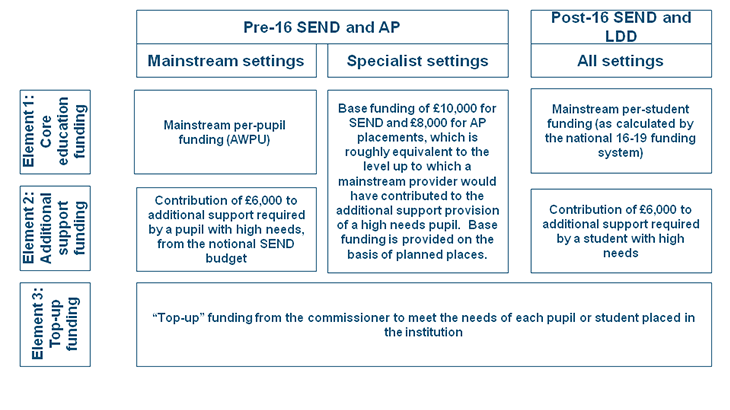Any provision management has to take place in the context of the special educational needs/disability budget.
The National Funding Model was implemented in April 2013 and introduced changes to funding for Academies and Mainstream schools. Funding is based on a combination of place and pupil led funding, known as the 'place plus' approach. This has been applied across all types of schools, academies, colleges, settings and alternative provision.
The Dedicated Schools Grant funding is now split into three distinct funding blocks for schools, high needs and early years. These are notional and not ring-fenced.
Further information on funding is available in the 0-25 SEND Code of Practice (2015):
- Early years providers: sections 5.59 - 5.60;
- Schools: sections 6.95 - 6.99;
- Colleges and 6th forms: sections 7:28 - 7:35.
For further information, read:
Department for Education (2012) Funding Reform: Next steps
towards a fairer system. London: DfE. [Online: https://www.gov.uk/government/publicatio
ns/school-funding-reform-next-steps-towards-a-fairer-system;
accessed: 14.2.15]

For schools, the National Funding Model consists of:
- Universal core education funding (age weighted pupil unit): a standard offer of high quality, differentiated teaching and learning for all pupils, including those with special educational needs;
- Targeted notional special educational needs budget (up to an amount agreed between schools and the local authority): additional support costs to meet a pupil's special educational needs; schools select evidence-based interventions that enable pupils to engage with learning and make expected progress; the notional special educational needs budget is not ring-fenced, but included in the school's overall delegated budget;
- Specialist/personalised high needs block top-up funding (for pupils with severe and complex needs – defined as 'High needs pupils' – requiring funding additional to elements 1 and 2 (above) paid through schools): funding will usually be allocated through the statutory assessment process; for a pupil to qualify for high needs block funding educational providers must show clear evidence of prior appropriate intervention and lack of progress; this funding pays for additional resources including Personal Budgets.
'High Needs Pupils are those whose learning needs are:
- Significantly "additional to" or "different from" the differentiated approaches and learning arrangements normally provided as part of high quality, personalised teaching;
AND
- When offering that support, there is irrefutable evidence that the cost to the school, per annum, is more than the Average Weighted Pupil Unit + £6,000 from the school's devolved additional needs funding;
AND
- When having been offered that support, there is evidence from school progress data and a compelling argument that more accelerated progress could be made if additional resources were provided, and the school has a specific, costed action plan (which might be part of an Education, Health and Care Plan) which outlines how High Needs Funding is to be spent and the targeted gains and outcomes;
OR
- When offering that support, there is irrefutable evidence that the cost to the EY setting, per annum is the 15 hours free entitlement funding + £500 from the group settings notional SEN [budget].'
(Northamptonshire City Council, 2014)

high needs
funding reform
(Department for Education, 2012)

Schools can choose to spend their notional special educational needs budget in a flexible way to meet the needs of most pupils with special educational needs/disabilities, including most pupils with high incidence special educational needs.
The formula agreed between schools and local authorities usually allocates more money to schools with a higher number of pupils with special educational needs/disabilities, and where there are more children receiving free school meals. The Government requires that schools are given enough money through the local funding formula so that they can meet the costs of special educational provision up to a nationally agreed sum and, in some authorities, a maximum number of hours support.
Special educational provision is anything that is provided to meet a child’s special educational needs that is additional to or different from provision made for all children.
(Dyslexia-SpLD Trust/Department for Education, 2014)
The SENCO has an important strategic role in agreeing a sufficient special educational needs budget with the headteacher and governors and deploying it to maximum effect, including the use of Local Offer resources.
It is essential to be able to justify budget spending by demonstrating that interventions selected for individuals or groups of pupils are:
- Appropriate;
- Evidence-based;
- Effectively implemented;
- Value for money;
- Impacting significantly on pupil progress;
- Evaluated for effectiveness.
The local funding formula will reflect the incidence of special educational needs and take into account such factors as area deprivation and prior attainment. A notional budget should not limit the amount schools spend on special educational needs/disabilities. Schools can appeal to the local authority if they can justify that their funding via the local formula is insufficient. Where their delegated funding does not reflect a school’s levels of special educational needs/disabilities, the local authority can provide additional funding from their high needs budget.

'Personal Budgets are a way of helping local authorities to use money better so
more people can get support in a way that suits them.'
(East Sussex County Council, 2011)
A Personal Budget is an amount of money identified by the local authority
to deliver provision set out in an Education, Health and Care (EHC) Plan where the
parent or young person is involved in securing that provision. The funds can be held
directly by the parent or young person (Direct Payment), or may be held and
managed on their behalf by the local authority, school, college or other organisation
or individual.
(See 0-25 SEND Code of Practice, 2015 (CoP), Glossary of terms, p. 284)
Their Local Offer must provide children/young people and their parents with access to the local authority’s Personal Budget Policy and with information about how to secure a Personal Budget. It should also describe the services across education, health and social care that 'currently lend themselves to the use of Personal Budgets' (CoP, 4.58).

'The key elements of Personal Budgets are that:
- The support is controlled by the family or young person if they are able.
- The level of support is agreed in a way which is fair, open and flexible
- Any additional help needed to plan, specify and find support is provided by people who are as close to the child or young person as possible.
- The way that Personal Budgets are arranged should be with an approach that puts children and their families in control and organises support solutions that make sense to them.'
The process of getting and spending a Personal Budget may involve the following stages: preparation – initial discussions with the local authority; assessment; planning related to specifics – eg funding and resources; approval process; payment; review; accounts audit.
(East Sussex County Council, 2011)
Direct Payments – where an individual or their parent/nominee receives cash themselves to contract, purchase and manage services identified in an Education, Health and Care (EHC) Plan – is one of six different ways of controlling a Personal Budget (0-25 SEND Code of Practice, 2015, section 3.38; East Sussex County Council, 2011). Direct Payments can be made only to either a person over compulsory school age who has the capacity (see Mental Capacity Act 2005) or assistance to manage them or to a parent or 'nominee' with authority to act on that person's behalf.
Before Direct Payments can be made, the local authority will need to be satisfied that:
- The provision agreed will be secured appropriately
- The provision will be secured in the child's/young person's best interests (if Direct Payments are made to a parent/nominee)
- That Direct Payments will not adversely affect other services
- That it is an efficient use of resources.
(Special Educational Needs (Personal Budget and Direct Payments) Regulations 2014, nos 2, 6)
Direct Payments

If there are conflicting issues around budget allocation/Direct Payments with
the child's/young person's early years setting, school or college, the local authority
must
not go ahead with the Direct Payment, but they should continue to explore ways
of personalising the provision under the Education, Health and Care Plan with all
concerned (eg a parent collaborating with the education provider to secure the desired
provision for their child) (0-25 SEND Code of Practice, 2015, section 9.105).

Find out the likely current levels of delegated special educational
needs funding in your area by consulting the Department for Education's most up-to-date
edition of the 'Schools Revenue Funding' and your local authority website operational
guide.
Plan ways in which, as a SENCO, you might strategically link the use
of the Local Offer to provision mapping in the context of your school's delegated
budget and maximise value for money.

Legislation and guidance
- Community Care, Services for Carers and Children's Services (Direct Payments)
- Regulations 2009 (the 2009 regulations will be replaced by those made under the Care Act 2014)
- National Health Service (Direct Payments) Regulations 2013
- Care Act 2014
- Children and Families Act 2014 (section 49)
- Special Educational Needs (Personal Budgets and Direct Payments) Regulations 2014
- Special Educational Needs and Disability Code of Practice: 0-25 years (Department for Education, 2015)
- Department for Education (2012) Funding Reform: Next steps towards a fairer system. London: DfE. [Online: https://www.gov.uk/government/publications/school-funding-reform-next-steps-towards-a-fairer-system; accessed: 14.2.15]
- Dyslexia-SpLD Trust/Department for Education (2014) Guidance: Supporting schools and local authorities to implement the SEND reforms for children and young people with literacy difficulties, specific learning difficulties and dyslexia. Bracknell: The Dyslexia-SpLD Trust/DfE. [Online at: http://www.thedyslexia-spldtrust.org.uk/4/resources/2/for-schools-and-local-authorities/279/online-guidance-on-the-sen-reforms; accessed: 16.3.15]
- East Sussex County Council (2011) Your Questions Answered: An introduction to Children and Young Peoples' Personal Budgets. Lewes: East Sussex County Council. [Online at: http://www.in-control.org.uk/media/111561/east%20sussex%20-%20personal%20budget%20faqs%20v1.pdf; accessed: 19.3.15]
- Northamptonshire County Council (2014) Northamptonshire's Special Educational Needs Descriptors: The entitlement of students in mainstream schools and early years settings. Northamptonshire: NCC. [Online at: http://www.northamptonshire.gov.uk/en/councilservices/EducationandLearning/special-educational-needs-disability-support/local-offer/Documents/DescriptorsSept2014AmendedDec14.pdf; accessed: 9.3.15]
- Making it personal 1: http://www.in-control.org.uk/what-we-do/children-and-young-people/useful-resources/making-it-personal.aspx
- Making it personal 2: http://www.kids.org.uk/mip2
- Making it personal 2 (Case studies): http://www.sendgateway.org.uk/resources.making-it-personal2-case-studies.html
- Nasen SEND Gateway: http://www.sendgateway.org.uk/
- SEND Pathfinder information pack on Personal Budgets: http://www.sendpathfinder.co.uk/infopacks/pb/.
- In Control/Department for Education Support and aspiration: introducing Personal Budgets: http://www.in-control.org.uk/what-we-do/children-and-young-people/publications/children's-programme-publications/support-and-aspiration-introducing-personal-budgets.aspx